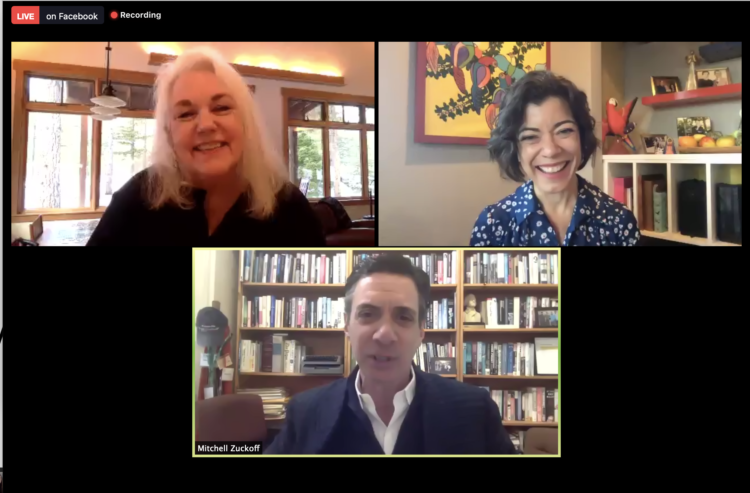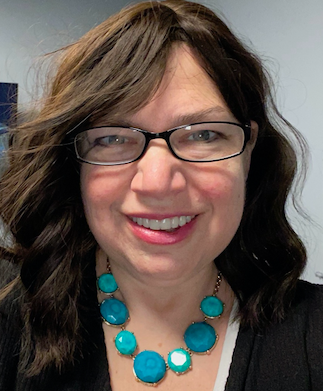
Jacqui Banaszynski and Fernanda Santos in a keynote conversation moderated by Boston University Professor Mitchell Zuckhoff at the Power of Narrative conference.
More than 3,200 people popped in for the free event. Conference organizers are already planning a hopeful return to an in-person gathering next year.
You can track some of the conference chatter on Twitter #BUnarrative or in threads under the names of speakers. In the coming days, Storyboard will post takeaways from each of the six sessions.
We start with a few high points from the opening session, a conversation between Jacqui Banaszynski and Fernanda Santos, about the power, challenges and ethics of intimacy journalism. The take-outs have been edited for length and clarity.Jacqui Banaszynski is a career newspaper journalist who now teaches and coaches journalists around the world. She is a professor emerita at the Missouri School of Journalism, a faculty fellow at The Poynter Institute, and (full disclosure) editor of Nieman Storyboard. She won the 1988 Pulitzer for Feature Writing for her narrative series “AIDS in the Heartland.”
Fernanda Santos is a Southwest Borderlands Initiative professor of practice at the Walter Cronkite School of Journalism and Mass Communication at Arizona State University. She spent 12 years at The New York Times. Her first book, “The Fire Line: The Story of the Granite Mountain Hotshots,” received the Western Writers of America 2017 Spur Award for Best First Nonfiction Book. She has recently begun exploring memoir and personal journalism.
Thoughts on traditional journalism vs narrative nonfiction
Santos: We are all born storytellers. We are born babbling and telling stories with characters that are doing something and going someplace and doing something for a reason. We are born with that skill. And then we get to journalism and we become stiff with facts. We forget we have a voice and arc and rhythm.
Banaszynski: Narrative takes us on a journey. It takes me somewhere I wouldn’t normally go – geographically, emotionally, spiritually, intellectually or financially. Over time, even the stock market is a journey.
Ethics and emotion in intimacy journalism
Santos: There is a power of healing in these kinds of stories. There is something therapeutic in giving someone the space to talk about themselves, and listening to them. But I also remind them that I am a journalist, I am telling your story. I am not their social worker, I am not there to solve their problems.
Banaszynski: Isabel Wilkerson called it “accelerated intimacy.” It is really rare to have someone sit with you and say “I want to know your life.” People tell you things because they haven’t thought anyone would hear them or listen, but you have to be careful that they know what your role is. We are not therapists. But one of the best ways of learning how to interview is going to a therapist yourself and paying attention to how they get you to talk, and how they use silence.
Getting people to open up and choosing what to disclose
Santos: This man that I interviewed, the one who spent half his life in prison for a crime he didn’t commit, he told me that he had never made love, never had sexual relations with a woman. And as a reporter, I’m thinking, “Wow, jackpot.” But I also asked whether he wanted me to write about that, to include it. He asked if I thought a woman would want to go out with him after she reads that? I said, “I think if she likes you, she would.” I thought it was the right thing to do for him.
Banaszynski: You have to be transparent with story subjects. When people ask us not to use information, it’s often not that they don’t want it used, but they want some sense of control — to know how it’s going to be used and why.
We are going to make mistakes and stumble. Sometimes we’re stiff in our interviews and we have to be able to say let’s set this aside and try again. It’s really a dance. The journalist is the one who leads, but the subject picks the music. I have to not trip them up or make them feel abused. It’s different from any other relationship I have.
Moving from daily journalism to long-form
Santos: The biggest challenge is to slow down. Take a deep breath. Things don’t happen so quickly. Take time to set the scene. Trusting myself was the hardest part.
Banaszynski: People are better off learning how to do pick-axe journalism on deadline first. All good writing requires good reporting. All great writing requires great reporting.
A few practical tips about managing a longform project
Santos: Tools like Scrivener help for multiyear projects. Be organized from the beginning.
Create a folder for each character with the raw transcripts and the edited transcripts. It’s hard to develop a system halfway through.
Keep reminding yourself what the core of the story is about. Keep it to one sentence, “This is the story of a man who spent the first half of his life in prison for a rape he didn’t commit.”
Banaszynski: Don’t wait to write. Do a daily self-debrief and write out what happened that day. That’s also how you discover the holes in your story.
I write the sections or scene I know when I’m ready and then figure out the full story later. So I write a lot of little stories and then stitch them together.
You can watch the full opening Keynote discussion with Banaszynski and Santos here:
***
Dawn Fallik is a journalist specializing in medicine and science, and an associate professor at the University of Delaware.


